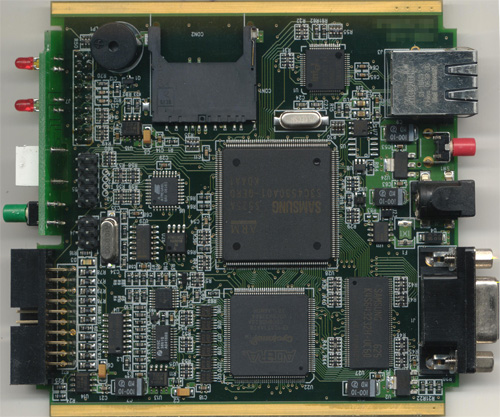The Ware for May 2009 is shown below. Click on the image for a much larger version.
Despite having to scan the board with about 1″ of stand-off height due to the connectors on either side of the board, the chip part numbers are still relatively clear. I’m liking this new scanner!
Sorry name that ware is running so late these days. Black Friday is “only” five months away and that means a consumer electronics hardware designer like me is busier than a one-legged man in a butt-kicking contest! But, the good news for blog readers is that I’ll have more stories to tell — and designs to share — once the press embargo lifts, after the products hit the market.

PEEDI JTAG/BDM
http://www.ronetix.at/peedi.html
Wow, that was fast.
Looking at the pictures:
http://www.ronetix.at/peedi-more.html
It looks very plausible.
Is this game getting too easy?
I’ve never understood these “universal” debuggers. Do you really have to pay separately for each supported target family, and for some devices even more for programming support?
Until this blog posting I hadn’t come across Ronetix/PEEDI before. Once I figured out that this was a JTAG/debugger board it took me several minutes to find a debugger that looked like this one as I was totally unfamiliar with Ronetix. That said, it does appear that the $2k debugger comes with one licence and each additional license is around $1200. That’s inline with the Albatron BDI3000s I’m familiar with, which are $2600 for the hardware and the first platform license, and $1k for each additional license.
If you’re looking for cheap OpenOCD supports a variety of low cost (<$100) debuggers like those from Olimex, etc. But if hardware is your day job the benefits of a proper debugger and supported software are worth every penny. It’s no fun constantly restarting gdb or openocd due to communication issues and the like. Not to mention the Olimex stuff can be downright buggy.
I would gladly spend a bit of money for a good universal debugger, but having to for out a grand per target and subscription fees and what have you is too much. I have used OpenOCD and several cheap FTDI-based dongles, but as you say, they are limited in several ways.
Wait, so if you hadn’t come across a Ronetix/PEEDI before, how did you guess it so quickly? What was the give-away?
It has an FPGA on it so that rules out consumer electronics. What has ethernet, RS232, and a 20 pin header on it? First thing that came to mind was a JTAG debugger device. I did various combinations of google image searches but came up empty handed. I then just started searching resellers of debuggers and tools which gave me the idea to search for “bdm”. I did an image search for “ethernet jtag dbm” which turned up the PEEDI device in the first few pages of results. I then confirmed on the Ronetix site that it was indeed the item in the picture. I think I spent a good five minutes searching and I was pretty confident it was a debugger. Had I not suspected it was a debugger I’m not sure how I would have come across it. Me thinks Ronetix needs to work on their search result rankings. Plenty of results with BDI in them.
Dang, I was considering cropping out the connectors on the edges to make the contest harder but I was thinking nobody would ever be able to guess it if I did! When I did the electric razor I had cropped all the important connectors and everyone thought it was an electric toothbrush.
“What has ethernet, RS232, and a 20-pin header?” LOL.
Bunnie, You’ve picked up some blog spam–check your template just after this:
style=”\64\69\73\70\6c\61\79:\6e\6f\6e\65″
Thanks…I think it’s gone now. Appreciate the notice, I don’t have the time to comb over my site for hidden spam like that.
I wonder which wordpress exploit was used to add that to the post. WordPress has developed a lot more exploits over time it seems (or perhaps more people are actively trying to exploit it).
What scanner did you use? Most flatbed scanners these days have abysmal depth of field.